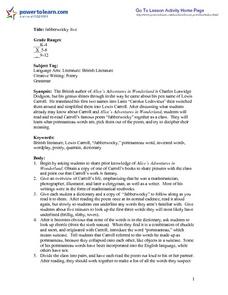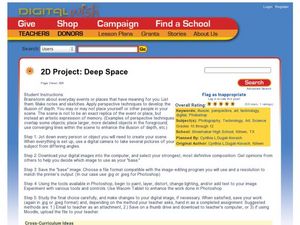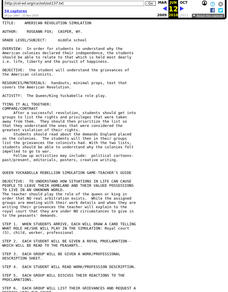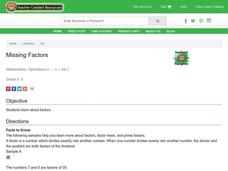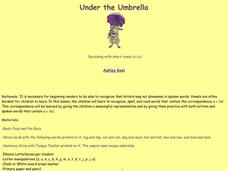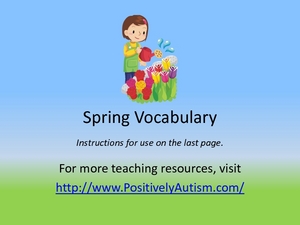Curated OER
Finding Polygons in Cubist Art
Fourth graders explore geometric properties and relationships in a two-dimensional work of art. They first search for and identify polygons in a Cubist painting and then use polygons to create their own Cubist portrait of a classmate.
Curated OER
The All About Me Poster
First and second graders become familiar with the components of a biography. In this language arts lesson, pupils create an "All About Me" page using components of a biography. They also create an interractive poster, and work with a...
Curated OER
"Jabberwocky" Jive
Pupils review the fantasy of Alice in Wonderland and discuss the author. After reading the poem, "Jabberwocky," they look up unfamiliar words in the dictionary. Working as partners, they create a list of "protmanteau" or invented words...
Curated OER
What Do Drugs Do to the Body?
Students research the effects that drugs have on the human body. Using this information, they create a poster showing some of the effects of a specific drug. They work together to summarize the information they have gathered and present...
Curated OER
We’re Going on a Bear Hunt
Second graders participate in guided reading and writing experience in this set of five lessons. They complete a picture walk of Michael Rosen's, We're Going on a Bear Hunt before listening to the story and retelling it. Working with a...
Digital Wish
2D Project: Deep Space
Using a digital camera, Photoshop, and a desktop paint program, learners will explore perspective techniques. They apply perspective techniques to develop depth illusions within a scene. The lesson employs both traditional art and...
Curated OER
Literature Study Guide: Gulliver's Travels
Although the title suggests this resource is devoted to Gulliver’s Travels, the materials and templates can be used with any work of literature. Readers fill out a reading schedule chart, write a summary, keep a vocabulary word list, and...
Curated OER
The Ashcan School of Artists
Complete with explanations and many examples of relevant paintings, this presentation takes students through the characteristics of the Ashcan School of Artists. The slides include works by artists such as Everett Shinn, John Sloan, and...
Curated OER
Two Word Problems
The class solves two basic word problems that requires addition or subtraction. They are encouraged to draw a picture that illustrates each problem.
Curated OER
Field Guide to Schoolyard Insects and Their Relatives
Your entire class works together to create an illustrated insect field guide. The intent is that they venture outside of the classroom, find a critter, and then research it using reference materials, insect books, and the Internet for...
American Physiological Society
An Inquiry into Alcoholic Fermentation
Introduce life science learners to their new "best buds" yeast! Using a wide variety of materials, lab groups design an experiment that illustrates how yeast acquires the resources it needs to undergo cellular respiration. The teacher's...
Curated OER
American Revolution Simulation: Colonial History, Drama
Learners explain why the American colonies declared the independence, students should relate to that which is held most dearly i.e. life, liberty and the pursuit of happiness. They participate in a drama that illustrates this.
Curated OER
"Logs of Straw: Dendrochronology"
Young scholars act as dendrochonologists working to reconstruct a 50 year climatic history. They make a personal timeline.
Curated OER
Virtual Winter Count
Learn more about the North American Plains Indian tribes and their unusual methods of recording historical events. Learners examine the winter count, a custom by which these groups illustrated information after each winter passed. They...
Curated OER
Ivan the Fool: Lesson 3
Students read and analyze the Eastern European folktale of 'Ivan the Fool.' They discuss the term 'quest,' identify quests in their own lives, and in small groups design a board game that illustrates the czar's quest to find good wives...
Curated OER
Exploring Hawaiian Mountain Zones
Fourth graders watch a video that describes the climate and vegetation zones of Hawaii. They describe the different physical conditions that create vegetation zones from the sea to the mountains. In groups, they create an illustrated...
Curated OER
Making Choices
Students explore the life of Harriet Tubman. They examine a painting of Harriet Tubman and consider the tools used to communicate information about her. Sudents describe how the color of a painting explains the mood of the illustrator....
Curated OER
Missing Factors
Students explore factors. They discuss factors, factor trees and prime factors. Students practice working with and finding various factors and prime factors. They discuss methods used to find factors.
Curated OER
Under the Umbrella
The unicorn uses Uncle's underwear! Practice saying this tongue twister with your young learners to illustrated the /u/ sound. After comparing pairs of similar words (like cut and cat) and their sounds, learners will read Fuzz and the...
Curated OER
Indian Story Bag
Students use an object to tell an interesting story from their lives. They write and present a short story about an interesting episode from their life and gather objects in a story bag, which illustrates their story to the class.
Curated OER
Land Use Change Introduction
Students discuss the major changes that have taken place in the Hudson Valley over the past 400 years. They use aerial photos to describe major trends in Dutchess County. Students view a PowerPoint presentation. They work in small groups...
Curated OER
Clothes
Let's go shopping! Featuring terms like blue jeans, high heels, and slippers, this ESL presentation would be a good addition to your unit about clothing. Each slide features one item of clothing, a fun illustration, and a short description.
Curated OER
Spring Time Vocabulary
Provide your autistic learners with the opportunity to build a spring related vocabulary. Each of the sixteen colorfully illustrated pages includes a corresponding word, intended to reinforce word recognition. This resource includes...
Curated OER
Name that animal
A great way to classify organisms, is by counting the number of legs it has or how it moves. Little ones count the legs on five different creatures, then match the leg count to the proper animal name. Tip: Have them come up with other...




